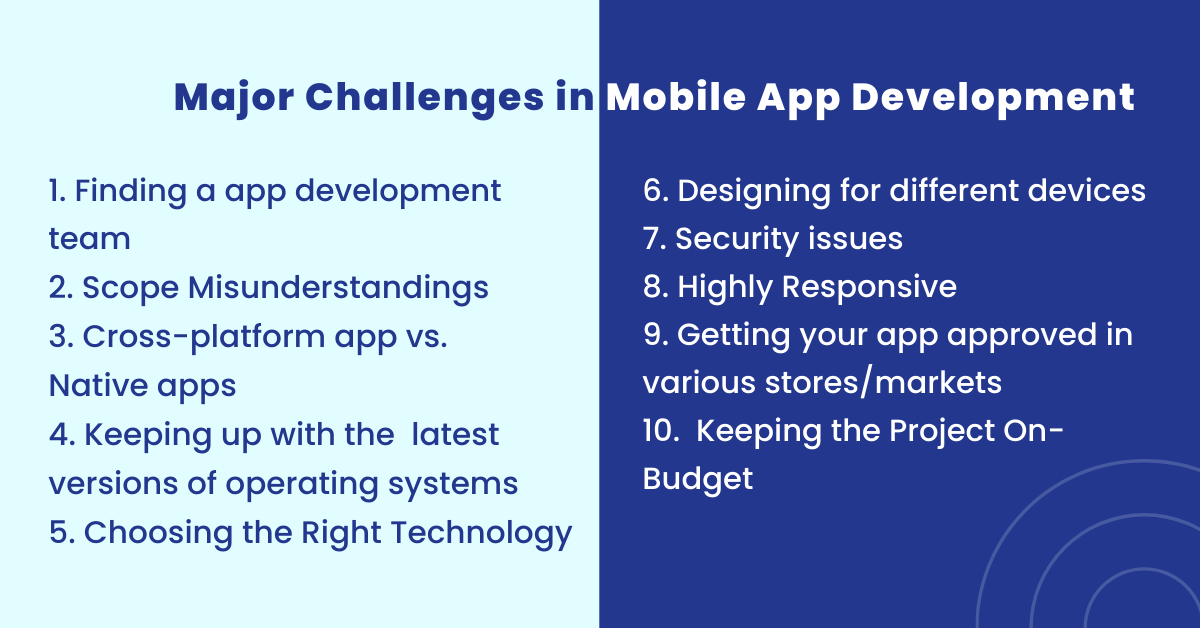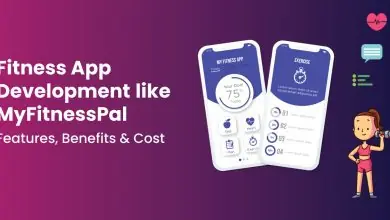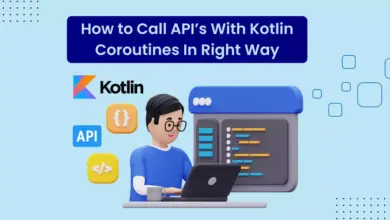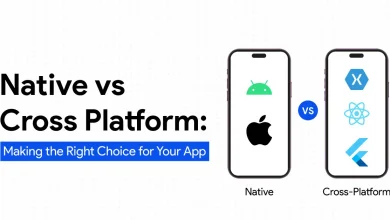Top 10 Biggest Mobile App Development Challenges

In this article, we’ll take a closer look at 10 mobile App development challenges you may face as you design your next big project for smartphones or tablets.
Mobile applications have turned into an important part of our daily lives. The market for Android and iOS app development is booming rapidly. High-performance and secure-based applications are considered one of the most lucrative opportunities in the current business scenario.
On the other hand, app developers have to face major mobile app development challenges also which include the difficulty in coding for various screen sizes to the need to keep up with changing device capabilities and connectivity options.
Major Mobile App Development Challenges You Should Know About

1. Finding an app development team
The process of finding the right app development team for your mobile app is not an easy one. First, you have to find mobile app developers who are skilled enough to develop a perfect app. You also need to make sure that they have enough experience in developing apps in different technologies and building successful products.
Besides their technical capabilities, you also need to pay attention to how good they are at communication, user interface design, and product marketing. If these things sound overwhelming for you, then it is best that you turn to professional outsourcing companies for help.
2. Scope misunderstandings
Not all features are equally important for your mobile app. If one feature overshadows another, it might be a sign that you’re out of scope. In that case, it’s time to negotiate and make sure both sides feel good about where you’re headed.
Scope misunderstandings can lead to budget overruns and timeline slips as developers try to interpret – and then agree to feature descriptions they didn’t write themselves.
3. Cross-platform app vs. Native apps
Native apps are created for a specific platform and can take advantage of specific features, such as push notifications. Cross-platform apps rely on common code that works across multiple platforms.
This means it’s easier to create a cross-platform app, but native apps perform better because they’re built specifically for a platform.
Hence, each has its own advantages and disadvantages, so make sure you evaluate which approach makes more sense for your project. In general, cross-platform tools are cheaper and more accessible, but native apps have a better user experience.
Choosing between these two options is the major challenge but it all depends on your budget and target audience.

4. Keeping up with the latest versions of operating systems
As new innovations are emerging on a constant basis, for developers, it turned into a major challenge to meet the steps with the latest industry standards.
For a successfully launching, programmers have to make sure that the app should support the latest operating systems. With the release of the new version, app developers have to make sure that the existing app or the app on which they working should support the latest version. Even after the delivery of the solution, app owners have to make sure that the app is updated with the latest versions.
Apart from that, now most consumers prefer to opt for app development services that provide automatic updations that allow them to opt for the new features, bug fixes, and security patches as soon as that release.
With major players such as Google, Apple, and Microsoft introducing two to three new versions of their operating systems every year and publicizing plans for regular updates beyond that, many smaller companies simply can’t keep up.
5. Choosing the right technology
Choosing a tech stack is one of the most important early decisions you’ll make. It defines everything else in your architecture, including how much time and money you’ll have to spend getting things right. But presently, several technologies and frameworks are introduced in the market and offer extensive functionalities to integrate into the applications to meet the user expectations and increase productivity by streamlining the development process.
Hence, among different technologies and frameworks to choose the right tech stack is turned into the next major iOS and Android app development process challenge. In order to overcome this challenge, developers should know the requirements of the project and keep updated with the latest versions of multiple technologies and frameworks that ensure to select the right one.
6. Designing for different devices
As more and more users are accessing mobile apps from their phones, tablets, or other portable devices, mobile app developers have to consider these differences in screen size. Ensuring your app’s design works for all screen sizes is key for user retention.
A mobile-friendly design will result in a positive experience across all devices. This will also help prevent low ratings and reviews, which can be detrimental to business success.
7. Security issues
When it comes to mobile app development, security is often a top concern for app developers and their users. The stakes are high with mobile apps because the information is easily accessible from anywhere, at any time. As a result, developers need to carefully consider how they handle user information.
The big question for developers is: How can you ensure that your data stays secure? One thing’s for sure—you don’t want users to lose faith in your ability to keep their information safe.
8. Highly responsive
One of app development’s biggest challenges is finding an effective and user-friendly way to deal with a device’s unique quirks. For example, a responsive design solution for a phone can be very different from one for a tablet, due to differing screen sizes and resolutions.
When users have trouble accessing your app via their mobile device, it will directly impact your success. If you’re building an app for users across multiple platforms, responsive design is essential.
9. Getting your app approved in various stores/markets
One of your biggest challenges will be getting your apps listed in various marketplaces, such as Apple’s iOS store or Google Play. It can take several weeks for approval, and even then you may be denied for reasons that aren’t immediately obvious to you. Make sure you have a plan in place to test your app and build up an audience long before you launch.
10. Keeping the project on-budget
One of your biggest challenges during mobile app development will be keeping costs in check. The longer you take to develop an app, or if you have to pay more developers, designers, testers, and other professionals for extra hours, your project can get out of control quickly. While it’s normal for projects to run a little over budget but it all depends on the clients.

Conclusion
The development of mobile apps is becoming increasingly popular among businesses and startups. However, to say that developing an app for mobile devices is easy would be misleading. With so many things to think about and consider, it’s no wonder some developers give up on their project before it even takes off.
Fortunately, we have compiled a list of the 10 biggest mobile app development challenges you may face while building your very own mobile app – and how to overcome them in time.





